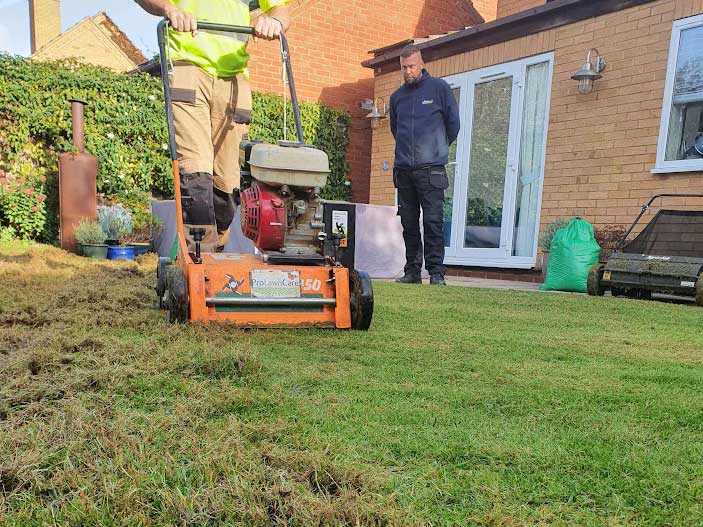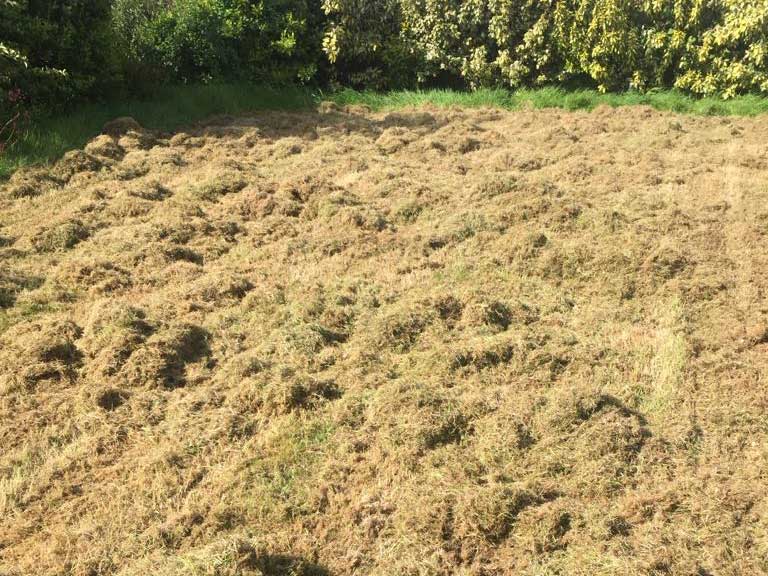Lawn Rescue: How to Tackle Thatch Build-up
26 August 2024
(Last updated: 22 Aug 2024 15:29)
Is thatch choking your lawn? Does the lawn feel springy as you walk across it? Is the grass less green than you’d like it to be? Perhaps water sometimes takes a long time to soak into your lawn -or worse - does it run straight off?
Thatch is a very common problem in lawns but it’s surprisingly easy to deal with. It’s a matter of tackling thatch build up and then implementing good ‘housekeeping’ techniques to keep this natural phenomenon under control.
Understanding Lawn Thatch. What Is It And Where Does It Come From?
If you were to cut a slice through your lawn, you’d likely see three distinct layers. First of all is the soil layer with (hopefully) a strong population of healthy grass roots. Next up comes the thatch layer, brown, fibrous and straw like - not unlike the top of a thatched cottage. Finally, the grass blades - the bit you can see clearly.
Thatch is perfectly natural, and in some ways it’s a consequence of healthy grass growth. However, a thick layer of thatch - more than around 6mm can be detrimental to the plants. Whilst a little bit of thatch protects and insulates the growing part of the plant from mechanical damage and harsh weather, too much of it can prevent water, air and nutrients getting to the plants’ roots and that will ultimately affect colour, vigour and disease resistance. If left to develop for too long, thatch can become such a problem for a lawn that the only remedy is a drastic renovation program. It’s far more cost-effective to keep thatch under control with regular interventions.

RICHARD SALMON
“Removing a small section of lawn allows you to clearly see the thatch layer”
How Does Thatch Form?
We mentioned that thatch is a consequence of normal grass growth, so let’s dig deeper for a moment to see how it is formed.
All grasses reproduce by seed. But some also ‘creep’, by producing side shoots or runners that put down roots to create new plants. This is a brilliant tactic, especially if you want your lawn to have an element of self repair. The tangle of side shoots (also known as either stolons or rhizomes depending where they sit in relation to the soil surface) helps the turf to knit together and form a dense sward. Which is a great way to create a smooth surface for sports such as bowls or golf.
Stolons and Rhizomes contain a compound called lignin. The word ‘lignin’ comes from the Latin ‘lignum’ which means wood. It’s a complex material which plays a very important role within plants. It helps provide structural support, protects against UV radiation, extreme temperatures and dehydration, and it’s also thought to form a physical barrier to stop pathogens entering the plant. So it’s pretty useful stuff.
The only problem with lignin, is when rhizomes or stolons die off, the lignin takes an awfully long time to decay. Layers of dead plant material build up until they become so dense that water and fertilisers simply cannot filter through to the soil. This is known as the thatch layer.

RICHARD SALMON
“a mechanical scarifier being used to rake excess thatch from a domestic lawn”
How To Get Rid Of Thatch In Lawns
Because it restricts the movement of water and nutrients, excess thatch in any lawn needs to be removed for the sake of plant health.
Unfortunately for lawn lovers, there is no chemical treatment to melt away thatch. The only way to shift it is to rake all of that dead material out of the surface of the lawn. A spring tine rake will do the job admirably, but it’s hard physical work and takes a very long time. The alternative is to use a powered rake-like machine known as a scarifier.
A scarifier slices through the dense thatch layer and lifts it away from the surface of the soil so that the debris can be removed and disposed of. We call this process scarification. Scarification also helps to remove moss.
It is perfectly possible to buy or hire a scarifier to treat your own lawn, however it’s probably cheaper and easier to hire a lawn care professional to do the job for you. Getting too enthusiastic with a scarifier can do more harm than good, so this task is best left to the experts.

STEPHEN BETTRIDGE
"Even seasoned lawn care professionals are often amazed at how much thatch builds up over time”
Scarification can leave a lawn temporarily looking a bit sorry for itself. It’s normally carried out in conjunction with aeration. The two operations optimise growing conditions for the grass plants and speed up recovery. In some cases, your lawn care specialist will also advise overseeding and/or feeding to create the lush green lawn that you dream of.
Is It Possible To Stop Thatch Forming?
Lawn scarification is like a deep clean for your lawn. It’s well worth doing but it takes time and energy. Wouldn’t it be better if you could just prevent thatch forming in the first place?
Different grass species have different growth habits, and this, combined with your soil type, microclimate and lawn care regime can influence the amount of thatch that forms in a lawn.
Ryegrass for example, doesn’t produce thatch at all. However it is often grown in conjunction with other grass species that do reproduce via stolons or rhizomes.
‘Fine’ grasses, which are normally associated with luxury lawns, bowling greens and golf greens, are inclined to produce stolons and rhizomes. That’s what creates that wonderful velvety texture we all love so much. However, the downside to that is thatch.
It follows then, that a ryegrass-rich lawn will produce less thatch than a fescue-rich lawn. However it’s important to also consider the conditions in your garden and the way you use your lawn before settling on the best species mix for you.
Remember too that gently scarifying regularly (once or twice a year) is far less work than allowing the thatch layer to become a problem that requires drastic action to resolve.
If you want to minimise the work of scarification, talk to your lawn care specialist who will be able to advise on finding a compromise between the appearance and functionality of your lawn, and the amount of work needed to maintain it.
Find a UKLCA lawn care specialist near you
Learn how and when to scarify your lawn.
Did you know that excess thatch can increase the likelihood of your lawn developing Red Thread Disease? Discover more in this blog
View other News